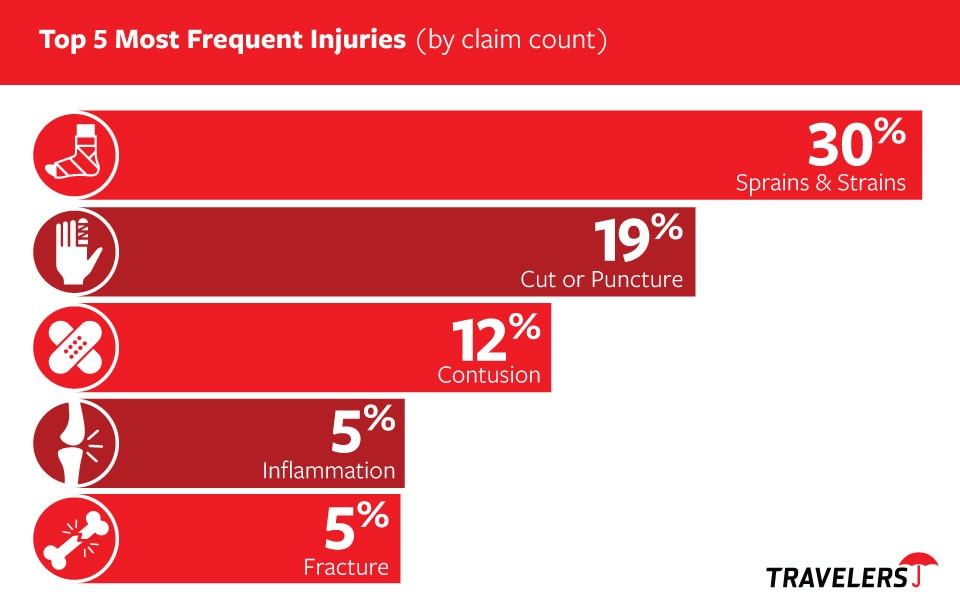 Of all public sector and private US businesses, roughly 3.7 million workers are injured per year. Businesses spend $170 billion per year on costs associated with occupational injuries and illnesses (according to OSHA) – and these findings provide critical insight on how the numbers add up.
Of all public sector and private US businesses, roughly 3.7 million workers are injured per year. Businesses spend $170 billion per year on costs associated with occupational injuries and illnesses (according to OSHA) – and these findings provide critical insight on how the numbers add up.
The nature of employee injuries in the modern workplace is changing in a variety of ways. Improved workplace safety management efforts over the past 25 years have led to a decrease in the frequency of workers compensation claims. During this time, Travelers has seen an increase in the severity of those claims.1 Preventing even a single injury, or managing the injured worker’s return to work as soon as medically appropriate, can have a significant impact on the health of your workforce and on your company’s bottom line.
The Travelers Injury Impact Report, an analysis of workplace injuries based on Travelers Claim data collected between 2010-2015, identifies the most frequent injuries, those with the greatest severity and the top causes of workplace accidents, both by industry and by business size. This information can be helpful for employers to understand how to manage their exposures and tailor training programs for their workforce in their particular market and industry.
According to the Travelers Claim data, strains and sprains topped all lists for most frequent types of injuries, except for small businesses, which experienced cuts and punctures most frequently, followed by strains and sprains. Contusions, fractures and inflammation rounded out the list of the top five most frequent injuries.

The report also explores the top five most frequent accident causes, with material handling topping the lists of most frequent causes of injury, followed by slips, trips and falls, struck by/striking against injuries, tool handling and cumulative trauma, according to claim count across all industries and all claims. “The injury type only tells part of the story,” explains Woody Dwyer, a Travelers Risk Control safety professional. “Identifying that root cause helps us determine the best strategies to help prevent future accidents and reduce their severity.”
As part of Travelers Workforce Advantage, Travelers Risk Control professionals can help businesses develop their strategies to attract, hire, onboard, train, support and engage their existing workforce. At its core, it focuses on the importance of elevating the company’s safety message, beginning with the recruiting process and continuing throughout the employee’s career at the company. The safety best practices, from safe lifting to getting adequate nightly sleep, can also offer health benefits beyond the workday for employees.
“A significant part of developing an effective risk management process involves understanding your unique workforce,” Dwyer said. This includes a shift in the state of health of the U.S. workforce, with more than half of workers experiencing at least one chronic health condition, such as heart disease, diabetes and arthritis. This can add cost and complexity to treating workplace injuries, which has led to rising medical costs for workers compensation claims.
If an employee does get injured, conducting an accident analysis can help discover the root cause of an accident, develop corrective action that can help prevent a similar accident in the future and continuously improve safety management practices.
Managing the employee’s injury so he or she returns to work as soon as medically appropriate can also help manage costs and improve employee morale. A Functional Capacity Evaluation (FCE) is one tool that can measure an employee’s current functional status and ability to meet the physical demands of a job, especially after a workplace injury.
In 2015, medical cost inflation topped the list of risk concerns for businesses, according to the Travelers Business Risk Index. Promoting the overall health and safety of your employees can help control costs while retaining an engaged workforce. Learn about how you can create a culture of safety and develop an injury management strategy at your business.
Injuries can happen at any time, anywhere, regardless of industry or business size. Knowing what those injuries are and their root causes can help companies develop workplace safety practices. To learn more about the most frequent workplace injuries, those with the greatest severity and the top causes of accidents by business size, industry and region, view The Travelers Injury Impact Report.
